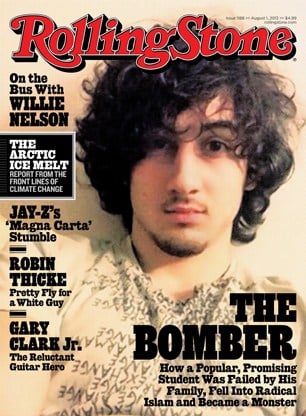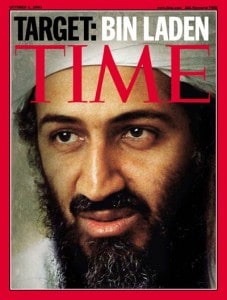Public opinion exploded this week over Rolling Stone magazine’s decision to publish a closeup photo of Dzhokhar Tsarnaev, the 19 year-old who allegedly conspired with his deceased brother Tamerlan to bomb the Boston Marathon in April of this year. Boston Mayor Thomas M. Menino penned a scathing public letter to the magazine, arguing that the decision “rewards a terrorist with celebrity treatment.” Massachusetts Governor Deval Patrick echoed this sentiment describing the photo as “out of taste.” Some retailers quickly announced that their stores would not sell the issue.
And yet the outrage isn’t usually about the article itself. Critiquing the photo, even Gov. Patrick acknowledged, “I haven’t read it, but I understand the substance of the article is not objectionable, it’s apparently pretty good reporting.” Though this is probably not a universally shared view, it is clearly widely held.
The actual @RollingStone report into the Boston Marathon bomber is superb, and important journalism: http://t.co/Hu81FHwsbb
— Piers Morgan (@piersmorgan) July 17, 2013
Indeed the coverage is hardly complimentary toward Tsarnaev; even the controversial cover declares in bold letters “THE BOMBER: How a Popular, Promising Student was Failed by his Family, Fell into Radical Islam and Became a Monster.”
Why, then, the eruption of emotion? Rather than indignation about the content or conclusions of the Rolling Stone article, the outcry seems to be about the image itself. Even Time Magazine (which has not been shy about featuring perpetrators of atrocities on its covers) published Four Reasons why Rolling Stone’s Cover Is Upsetting, highlighting responses to the cover image. A friend of a victim declared in an open letter to Rolling Stone, “Your use of a provocative, borderline sympathetic image and headline of someone who has caused so much pain to our country is appalling, insensitive, and disgusting.” In a July 18th editorial, Ty Burr of the Boston Globe wrote:
“He is the picture, literally, of a relaxed, sincere, slightly mysterious young dude….By putting this Tsarnaev on the cover, Rolling Stone at best plays with and at worst buys into the accused’s own manufactured image, casual but potent, speaking in a language we all understand.”
Ian Crouch has called this “The Inconvenient Image of Dzhokhar Tsarnaev” in his fantastic commentary for The New Yorker. “But just because something sparks outrage,” remarks Crouch, “doesn’t mean that it is outrageous.” Many have complained that the cover gave Tsarnaev “rock star” treatment: a closeup of a tousle-haired, relaxed, even attractive young man, inviting comparison with any number of long-haired stars that have graced the magazine’s cover. But as Crouch points out, “What we didn’t see, and what perhaps we longed to see in our grief, or anger, or confusion, were any familiar images of the Islamic terrorist.” (This, of course, raises a further disquieting question: if Crouch is right, what do people think “Islamic” looks like?) Given that the Tsarnaev brothers are ethnic Chechens, is it possible that we wanted him to look less, well, Caucasian?”
There are excellent reasons for victims, their friends and family, and many others to react viscerally to the image of their attacker. The bombings were an act of incredible evil, and no doubt this episode will reactivate memories of the trauma that so many have suffered. Likewise, the impulse to focus on the victims as the “real” story, as Mayor Menino has encouraged, is understandable. Their stories are a tremendous sign of grace at work in a broken world.
But is Dzhokar Tsarnev’s story any less “real”? As Crouch rightly suggests, demanding that Tsarnev look and feel the part of a prefabricated monster is a form of “cultural self-censorship” in which “certain responses are deemed correct and anything else is dismissed as tasteless or out of bounds.” The implication that a picture of an accused terrorist is too attractive, or borders on “rock-star” treatment, points to our desire to manage chaos, to cram tragedy into a pre-packaged narrative of brave victims overcoming devastation wrought by (physically/spiritually/psychologically) ugly terrorists.
Lurking in these conversations is the implication that publishing an attractive picture somehow diminishes the magnitude of what Tsarnaev stands accused of doing. It does no such thing. Far more disturbing is the fact that against all biases of what evil “should” look like, an attractive, modest, apparently well-liked person committed this terrible crime. And that fact, above all, is what makes articles like Rolling Stone’s not only in good taste, but utterly necessary.
—//—
Cover image Dzhokhar Tsarnaev on the cover of Rolling Stone Magazine, accessible here. © 2013 Rolling Stone Magazine. All rights reserved.



